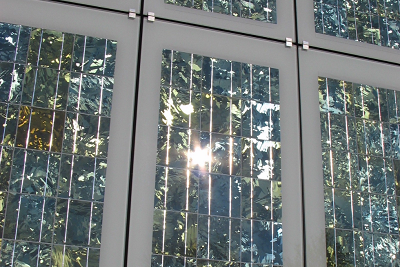 Friday, July 26, 2024
Friday, July 26, 2024  Friday, July 26, 2024
Friday, July 26, 2024 

The windows of many cars and buildings often are tinted with a film that shuts out unnecessary sunlight, an energy efficiency measure that helps lower heating and cooling costs. Other types of environmentally friendly windows feature a coating of see-through solar cells that transform the windows into mini generators of electricity. But you probably won’t find any windows anywhere that can do both. Not yet anyway.
This could be about to change. Chinese scientists have invented a new material that can both block the sun and produce power. They predict that windows outfitted with this product—or even window curtains that have it—eventually could cut the average household’s electric bills by half or more.
“We combine both material innovation and optical thin film design to achieve the goal of combining both solar electricity generation and heat insulation in one single film,” said Hin-Lap (Angus) Yip, a professor of materials science and engineering at the South China University of Technology. “Our energy efficiency for the house is kind of double: power generation and power saving.”
Click here to sign-up and receive the Weekly Round Up in your inbox every Saturday
Constructing a prototype that could simultaneously make electricity and prevent excessive heat required the scientists—who also included Fei Huang, also of South China University—to perform a balancing act between harvesting light to make electricity and blocking it, mixing and matching from among a variety of materials and chemical compounds to find exactly the right working combination.
Eventually, they designed a product that allowed visible portions of sunlight to pass through, but rejected infrared light, which is “a major heating culprit,” Yip said. The researchers then transformed the near-infrared region in-between into an electric current.
“The major material we used for turning the solar light to electricity was a polymer semiconductor,” Yip said. “We can design the chemical structure and tune [its] absorption property. This organic material has very unique absorption property, which can selectively absorb the near-infrared light, [but] allow a major portion of visible light to pass through it, making it a perfect material for semitransparent photovoltaic (PV) window application.”
Current solar cell technology based on silicon or other inorganic semiconductors is not suitable for photovoltaic window applications “as they are opaque and dull in appearance,” he added. “Instead, we can make organic photovoltaics into semi-transparent, lightweight and colorful films that are perfect for turning windows into electricity generators and heat insulators.”
A paper describing the research appears in the journal Joule.
Watch our video and learn more about the benefits of joining Construction Links Network – the peer-to-peer network sharing platform for the construction, building and design community.
Press Releases | Project Updates | New Appointments | Awards & Milestones | Company News | New Products/Services | Brochures | Videos | Infographics | Blog Sharing | Events and More